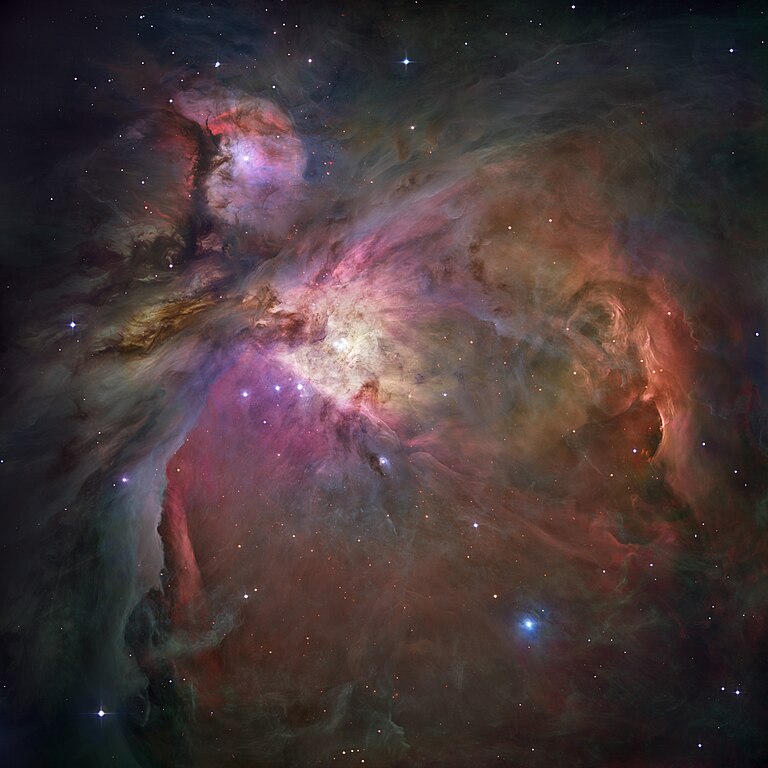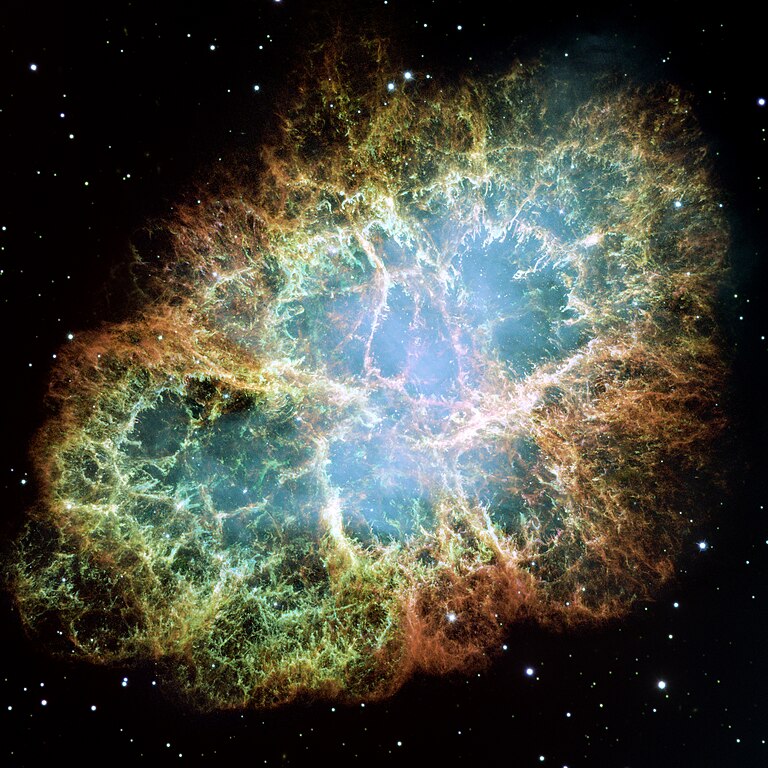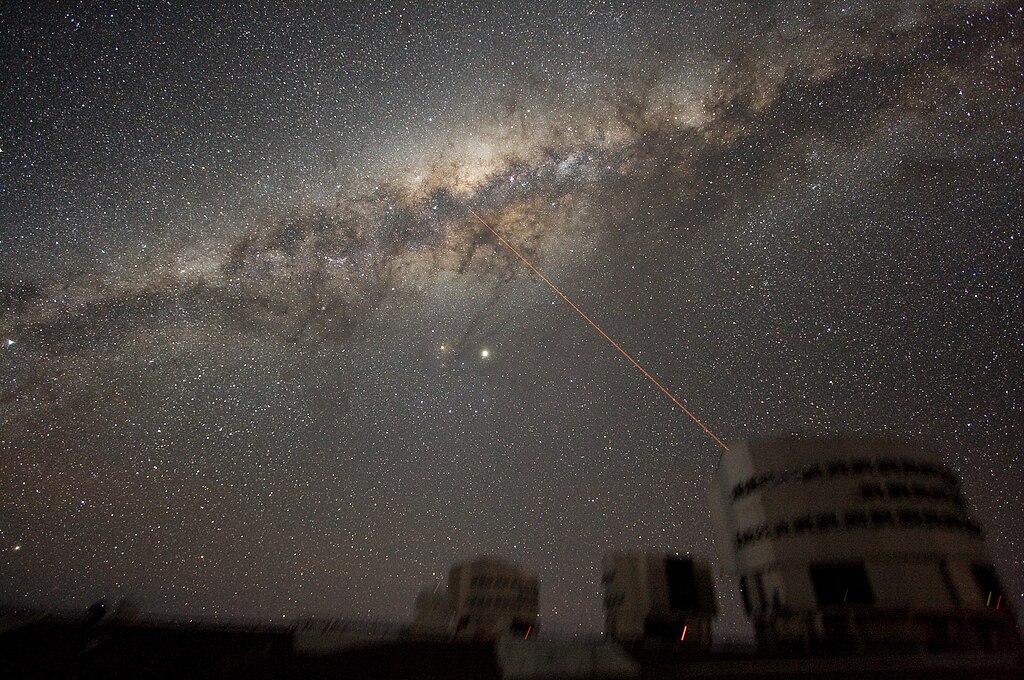The title (and the multiplicity of vowels therein) is inspired by a hugely unknown Metallica song from the Garage Inc. album called... well, 'Astronomy' - which is, like everything on the album, a cover. The original song is by Blue Öyster Cult. Do check it out (both versions are pretty cool)!
So, to illustrate that I won't be talking only about quantum mechanics here, let me share some random thoughts about some astronomical images. Like, maan, nebulas are pretty:
This one is a vary famous one, the Orion nebula. Credit for the image goes to the Hubble Space Telescope, which has in fact done an amazing job: the actual resolution of the image is 18,000 by 18,000 pixels, and a fun zoomable version is available here. Until recently I had never thought about how big nebulas actually are, but I know that they are formed after a star burns out and explodes into a supernova, so I thought that gave me a pretty good idea. They turned out to be slightly bigger than that idea, but not too much. Well, although I cannot say that they are huge by astronomical standards (insert a 'your mom' joke here), they certainly are pretty huge for something created by a single star. Let's stop for a second and admire another one.
That's the Crab nebula. Credit goes again to Hubble, and again there is a zoomable version. Pretty amazing, huh? Let's see how big it is. Let's start from the standard comparison, Earth, Sun, distance between the two.
On the left side, the dot representing the Earth is to scale compared to the ball that is the Sun; on the right side, the dot representing the Sun is to scale with the Earth-Sun distance, but the dot representing the Earth is obviously not. The distance between the Earth and the Sun is a unit of length commonly used in astronomy, and as such, it's rather appropriately named... 'astronomical unit'. 1AU is about 150 million kilometers. And here is how this distance compares to the rest of our Solar System (and a bit beyond! Have you heard that Voyager 1 not long ago became the first mam-made object to leave our star system?)
We're however still far from the required length-scale to describe the size of a typical nebula, i.e. they are much larger than the entire Solar System! I cannot come up with anything familiar whose size is in between the Solar System and the nebula size I am trying to get to. Also, I seem to have an unexpected problem in writing this post in that I want to put a 'your mom' joke in almost every paragraph. Resisting the temptation, let me define the size of the Solar System (twice the distance from the sun to the heliopause) as a unit of length, for which I'll use the (unfortunate) abbreviation SS. For people more familiar with standard internet units of measure, 1SS is approximately 179.51744 × 1012 bananas, although it depends where you buy them from. That's 179.5 trillion, for the people unfortunate enough to not understand scientific notation.
Ok, so having defined that, we can define one Deca-SS (10 times SS), and one Hecto-SS (you guessed it!).
The Hecto-SS is a unit that's finally big enough to be visible on the scale of the Crab nebula.
More precisely, the nebula is about three thousand times bigger than our entire Solar System! So, yeah, pretty big, huh? Or maybe you're disappointed, cause you expected it to be bigger? (zing!) Anyway, with astronomical distances it's really hard to know what to expect, but now you do, in case you ever want to be a millionaire (and by incredible chance you get asked just that).
Now, what got me thinking about nebulas in the first place was not their size. Instead, I was wondering if the above images are just pretty pictures, or if they are a representation of reality. This is because scientific images which are taken using some apparatus, like a telescope or a microscope, are sometimes in 'fake color', which means that the apparatus does some coloring following some rules. There is usually a very good reason to do that, and the rules usually encode some information in the colors. So what about the nebulas, could we ever hope to see them in all their majesty (i.e. as in the images above) with the unaided eye? Not exactly. First of all, to see the nebulas as big as in the images, we would definitely need some aid: either a telescope, or, if we have somehow gotten close enough to need no magnification - a filter, because the light will be too bright. But in addition to that, for nebulas, Hubble does use a color-coding: namely, it assigns a particular color to a particular chemical element. For example, in the image of the Crab nebula, blue represents neutral oxygen, green indicates singly-ionized sulfur, and red indicates doubly-ionized oxygen.
So, then, are those just pretty images, or are they also an accurate portrayal of reality? I would say that they are the latter. What is reality anyway - we definitely cannot restrict the definition to whatever we can see with our eyes. And in a way, in the Hubble images reality is portrayed even better, because, while the nebulas will no doubt still look stunning unmodified, this color-coding allows us to differentiate the constituent elements even better. In other words, as long as the image conveys scientifically accurate information, to me it is indeed a representation of reality, regardless of what part of it our eyes could see if unmodified. Take as another example this stunning image of the Milky Way
This is reality right there, it's something that is always just above our heads, ready to be gazed at, but we can never hope to see it like that (unless we teach our brains to take long exposure shots...) But still, this awesomeness exists above us and it is only our sensory limitations that prevent us from appreciating it. Fortunately, however, we are getting better and better at using tools to capture reality, and represent it in an accurate way that our crippled senses could actually appreciate. Great stuff.
But this is not always the case: there is another type of 'fake' images which sometimes appear especially in relation to astronomy, and that brings me to the original inspiration for this post. This image of a recently discovered exoplanet became mildly viral in the last weeks
Now, the important thing to realize here is that everything we know about Kepler-186f is inferred through observations of the star it orbits; we have no way of capturing any image of the planet itself, let alone one as detailed as the one in the picture. What's nevertheless pretty cool is that just by observing the star, we can infer with quite a lot of certainty that there has to be a planet orbiting it, and, furthermore, we can estimate the size and orbital radius of the planet. Based on this, we know that around a certain star there orbits a planet that's slightly larger and slightly colder than the Earth, but that's literally everything we know with certainty. We don't even know its mass, so we can only guess what it could be made out of, and we certainly have absolutely no idea if there's water or not. So the planet on the left is just someone's imagination of what a slightly larger, slightly colder Earth could look like - one of the infinite number of possibilities. Unlike the Hubble images, there is nothing scientifically accurate in the details of this picture. Images of this type are called 'artist's conception'. Don't get me wrong, I'm not calling the image fake or anything, and I'm not against images like this, but I do think that if they belong to that type, that should be made very, very clear, because a lot of people could be fooled.
To conclude, since I mentioned the Milky Way earlier, we all know and love our home galaxy, right?
But this is not the Milky Way! That's another galaxy (NGC 6744), and we just think that the Milky Way should look something like this. It took me an embarrassingly long time to realize that we cannot take an 'outside' picture of the Milky Way like the one above, cause we are hopelessly trapped on the inside of it. To put it simply, we don't have a giant, inter-galactic selfie stick.










if you want to book cheap and best india tour please visit our website we have india prime tour operators provide best tour packages at cheap and best price, Tour Operators in India
ReplyDelete